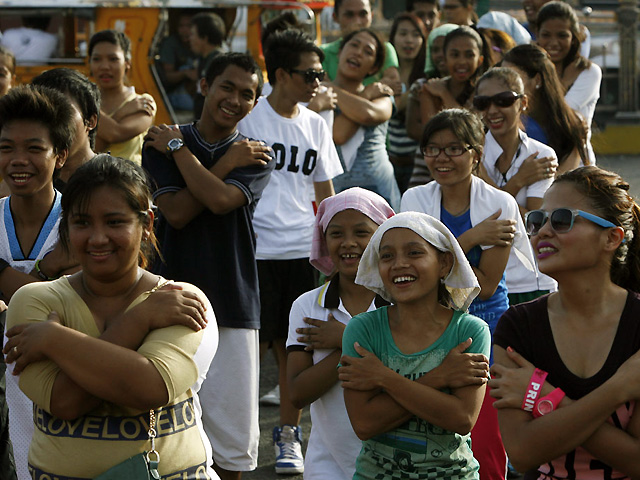
Participants in 'Pinoy Laughter Yoga', a form of physical exercise that includes laughing, dancing, jumping and chanting which improves not only mobility, communication and relationships but also boosts morale. Reuters/Romeo Ranoco
Apart from smiling often, Filipinos also laugh a lot. We make jokes all the time—whether among strangers or friends, in the classroom or at work, about our personal lives or politics. Popular radio stations air recorded jokes every few minutes, followed by canned laughter. Of course, there are preferences for different types of humor, but it seems there is a “national humor,” used to reduce conflict. This was demonstrated in a research on humor by Dr. Maria Rhodora Ancheta of the Department of Comparative Literature, College of Arts and Letters, University of the Philippines Diliman. "Ancheta believes that national humor is a potent showcase of 'Filipino-ness,' and evidence of how Filipinos maneuver within the frames of their local and national experiences," Gracious Romero writes in an
article entitled "Why the Filipino Laughs" on the website of the Office of the Vice Chancellor for Research and Development. In her research paper "The National Humor of the Philippines: Defining Filipino Humor in Contemporary Popular Culture Forms (Phase 1)," Ancheta analyzed comic strips, comedy films, popular theatrical forms as well as internet-based animation. Romero notes that "comedy in Filipino pop culture veil the tactics used to battle the ordinary Filipino's disempowerment in Philippine society." She explains that citizens can get back at authority using political jokes, which carry Filipino values such as "hiya" and "loob." Jokes allow people to tackle real problems "in a manner that does not create tension," anthropologist Dr. Clemente Camposano, director of the Institute of Political Economy in the University of Asia and the Pacific is quoted in a PCIJ article by Camille De Asis, Ival Lim, Mark Tare and Angela Poe. [http://pcij.org/stories/joke-the-vote-pun-the-bets/] Using laughter to survive is common all over the world, according to Ian Jarrett's article entitled "Laugh Out Loud" in Discovery Channel Magazine. "Laughter seems to be common across cultures and universally recognizable, but scientists point to a hidden agenda to the simple act of chuckling," Jarrett writes. Apart from being used to express joy or amusement, laughter also functions as "social glue," as Dr. Sophie Scott puts it. Scott led a study by the University College London, which showed that laughter is a universal human vocabulary. According to Scott, people laugh in order to get closer to each other. "Laughter is social glue that makes and strengthens our links with other people," Jarrett quotes Scott. In the University College London study, researcher Dr. Disa Sauter studied the semi-nomadic Himba people in northern Namibia. Sauter found that despite not being familiar with each other, the two cultures recognized each other's laughter as mirth. "Laughter is a widespread human trait and expression," Jarrett quotes Scott. Laughter is also a tool to gain acceptance. English comedian Jimmy Carr says jokes are a way of telling another person, "I like you and I want you to like me," Jarrett writes. Carr says sharing jokes gives people a sense of belonging to a particular group. And as shared laughter indicates acceptance, it can also be used to exclude. Jarrett explains, "This is the difference between laughing with someone, and laughing at someone." Meanwhile, author Dave Barry says laughter is a coping mechanism, as it gives people a release from fear. "You know, when the Challenger [space shuttle] went down, there were Challenger jokes all over the country. Not because people didn't think it was a tragedy, but because people have to react somehow to those unacceptable horrible things that happen all the time...So I think it's that release from anxiety that makes people laugh," Jarrett quotes Barry. While the reasons for laughter vary, there are good reasons to do it often. According to Dr. Lee Birk, who led a study of the interaction between the brain, behavior and the immune system, "the anticipation of a happy laughter experience lowers levels of three stress hormones: cortisol, epinephrine (also known as adrenaline), and dopac," Jarrett writes. A 2005 study also reveals that laughter helps blood vessels function better. Participants watched a funny movie on one day, and a stressful segment opening on another. Blood flow was reduced by 35 percent on average when watching the latter. On the other hand, watching the funny movie resulted in a 22 percent increase in blood flow, Jarrett writes. "The magnitude of change we saw in the endothelium (the inner lining of blood vessels) after laughing was consistent and similar to the benefit we might see with aerobic exercise or statin (a class of drugs administered to reduce levels of cholesterol in the blood) use," Jarrettt quotes study leader Dr. Michael Miller, director of the Center for Preventived Cardiology at the University of Maryland Medical Center in the US. Jarrett explained that endothelium has an effect on blood vessel tone, and regulates blood flow, adjusts coagulation and blood thickening, and produces chemicals in response to injury and inflammation. "The old saying that 'laughter is the best medicine' appears to be true when it comes to protecting your heart," Jarrett quotes Miller.
—KDM, GMA News 




